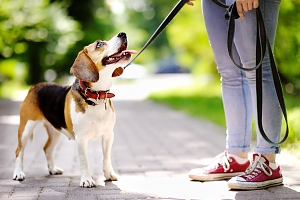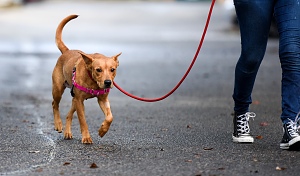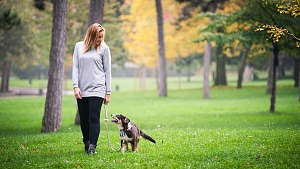Taking a dog for a walk is an excellent form of exercise for both the owner and the canine companion. In most urban and suburban settings, it is mandatory to keep dogs on a leash when in public spaces, such as neighborhoods, trails, or parks.
Even if local regulations don’t enforce leash usage, it is often a vital safety precaution to safeguard dogs from potential dangers like traffic, other animals, or the risk of running away. Therefore, the question arises: How can one effectively train their dog to walk on a leash?
Guide on Leash Training for Dogs
 While the notion of leash training might seem straightforward, the process can pose challenges, depending on the temperament of the dog. The key is to approach it gradually, introducing each phase slowly to ensure the dog fully masters one skill before progressing to the next.
While the notion of leash training might seem straightforward, the process can pose challenges, depending on the temperament of the dog. The key is to approach it gradually, introducing each phase slowly to ensure the dog fully masters one skill before progressing to the next.
Here’s a step-by-step guide on how to train your puppy or dog to walk on a leash.
Familiarize Them with the Equipment
Familiarizing your dog with the equipment is a crucial step in leash training, as many dogs initially find wearing a leash, collar, or harness uncomfortable or unfamiliar. To address this, take a patient and gradual approach to make the introduction a positive experience for your canine companion.
Begin by allowing your dog to wear the leash, collar, or harness for short periods while indoors. Choose a comfortable and quiet environment where your dog feels at ease. Use treats, toys, or playtime to create a positive association with the gear. Engage in playful activities, such as tossing a favorite toy or playing a short game of fetch, while your dog is wearing the equipment. This serves to distract your dog from the new sensation and associates it with enjoyable experiences.
During these initial sessions, observe your dog’s body language for signs of discomfort or anxiety. If your dog appears uneasy, offer gentle reassurance and continue with activities that they enjoy. Gradually increase the duration of time your dog spends wearing the leash or harness, ensuring that each session remains positive and stress-free.
As your dog becomes more accustomed to the equipment, incorporate basic commands into the training sessions. For example, practice commands like “sit” or “stay” while your dog is wearing the leash. This reinforces the idea that the leash is part of a routine, making it a natural and expected aspect of their interactions with you.
By taking the time to familiarize your dog with the equipment in a gradual and positive manner, you are laying the foundation for successful leash training. The goal is to build confidence and comfort, so your dog associates the leash or harness with enjoyable activities and positive interactions. This initial investment of time and patience will pay off as your dog becomes more at ease with wearing the gear, setting the stage for a smoother transition to leash walking in different environments.
Positive Reinforcement
Positive reinforcement is a powerful tool in the ongoing process of leash training, helping to reinforce desirable behaviors in your dog while fostering a strong bond between you and your canine companion. After ensuring that your dog is comfortable wearing the leash or harness and can respond to basic commands, the next step involves incorporating positive reinforcement into your walking routine.
Initiating Short Walks
 Once the foundation is set, gradually transition to short walks around the neighborhood. Keep these initial walks brief to allow your dog to acclimate to the outdoor environment while maintaining their focus on you. Short walks also help prevent overstimulation, making it easier for your dog to follow commands and exhibit positive behavior.
Once the foundation is set, gradually transition to short walks around the neighborhood. Keep these initial walks brief to allow your dog to acclimate to the outdoor environment while maintaining their focus on you. Short walks also help prevent overstimulation, making it easier for your dog to follow commands and exhibit positive behavior.
Using Cues and Commands
Employ specific cues or command words that your dog has become familiar with during indoor training. Consistency is key, so use the same cues consistently to communicate expectations. For instance, a simple “heel” or “walk” command can signal to your dog that it’s time to maintain a specific position alongside you.
Rewarding Compliance
Whenever your dog responds appropriately to your cues or commands, promptly reward them with treats. This positive reinforcement strengthens the connection between the desired behavior and the enjoyable outcome of receiving a treat. Choose treats that your dog finds particularly enticing, creating a strong motivation for them to follow your guidance.
Addressing Pulling on the Leash
If your dog starts to pull on the leash during the walk, it’s important to address this behavior promptly. Instead of allowing the pulling to continue, stop walking and gently encourage your dog to return to your side. This teaches them that pulling on the leash leads to a standstill, discouraging unwanted behavior. When your dog returns to a desirable position, resume walking and reward them with praise and treats.
Consistency is Key
Consistency is crucial in reinforcing positive behavior. Repeat this process consistently during each walk, reinforcing good behavior and addressing any pulling promptly. Over time, your dog will associate walking calmly alongside you with positive experiences, making them more likely to exhibit the desired behavior consistently.
Gradual Progression
As your dog becomes more adept at walking on a leash without pulling, gradually increase the complexity of the environment. Introduce new distractions or challenges, such as other dogs, pedestrians, or different terrains. Continue to use positive reinforcement to encourage focus and obedience in various situations.
By incorporating positive reinforcement into your leash training routine, you not only encourage good behavior but also create a positive association between walking on a leash and enjoyable experiences for your dog. This approach fosters a strong and trusting relationship between you and your canine companion, making walks a pleasurable activity for both of you.
Addressing Behavioral Issues
Some dogs may exhibit behaviors like barking or attempting to chase after other animals during walks. To address these issues, ensure the dog gets sufficient exercise to minimize excess energy. Use treats and positive reinforcement to discourage barking or chasing behavior. If necessary, employ specialized harnesses or collars designed to curb pulling.
Consistency and Patience
 Effective leash training relies on consistent reinforcement of desired behavior and distraction from undesirable actions. Praise the dog for walking calmly without pulling or lunging, and offer treats as positive reinforcement. Keep the leash short to encourage walking beside the owner. With patience and consistency, dogs can learn to walk on a leash obediently.
Effective leash training relies on consistent reinforcement of desired behavior and distraction from undesirable actions. Praise the dog for walking calmly without pulling or lunging, and offer treats as positive reinforcement. Keep the leash short to encourage walking beside the owner. With patience and consistency, dogs can learn to walk on a leash obediently.
Reach Out to Northern Virginia’s Professional Dog Walking Services
Paw Pals Pet Sitting is here to help you maintain and re-enforce those excellent habits and ensure your furry friend enjoys regular exercise all year round. Our dedicated dog walking services provide routine walks tailored to your dog’s needs, promoting their overall health and happiness.
Entrust your pet’s well-being to our experienced team, as we make every effort to create a safe and enjoyable walking experience for both you and your beloved canine companion. Don’t hesitate to contact us to schedule a Northern Virginia dog walker.


